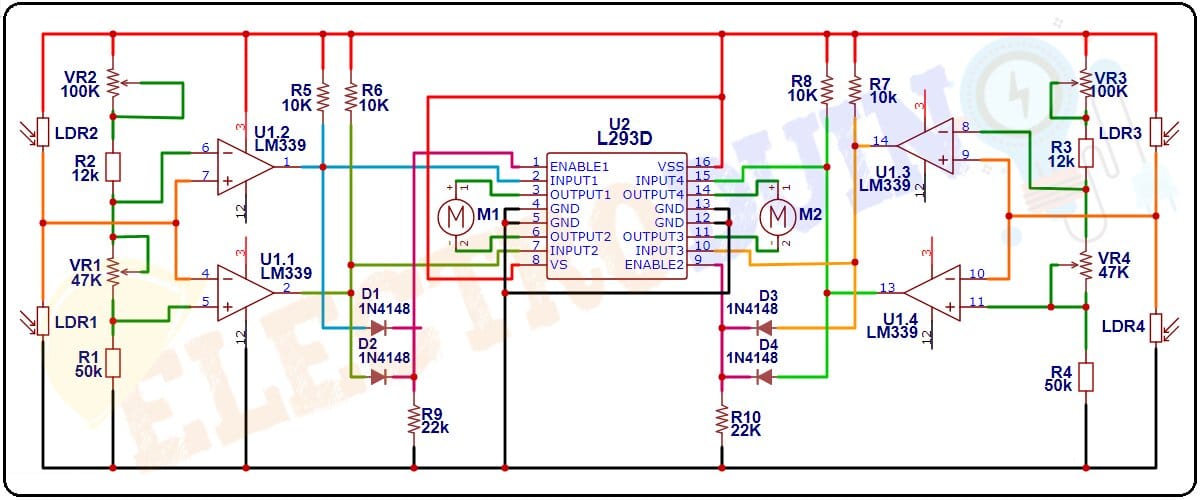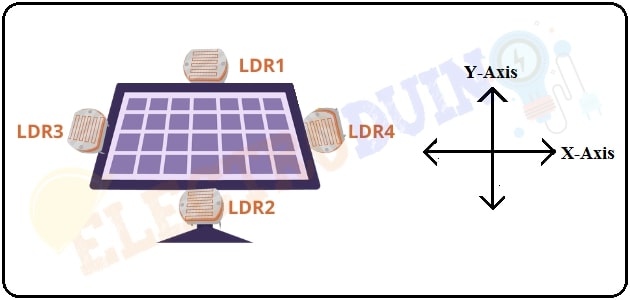Dual Axis Solar Tracker using LM339 and L293D
Hello friends! Welcome back to ElectroDuino. We have already learned How to Make a Single Axis Solar Tracking System in the previous blog tutorial. This blog is base on Dual Axis Solar Tracker using LM339 and L293D motor driver IC. Here we will discuss Introduction to Dual Axis Solar Tracker, Project Concept, Block Diagram, components required, circuit diagram, working principle.
Introduction
Solar energy is the fastest-growing and high demanding renewable energy. Solar energy takes an important role as a primary source of energy, mainly for rural areas. When sunlight (photons) falls on a solar panel, then it produced electricity. Most of the solar panels are fixed in a particular position and direction. We all know that the sun moving from east to west, but normal solar panels can’t move. For this reason, these types of solar panels can‘t consume maximum sunlight from the sun. So, electricity production power will be decreased.
In this project, we will make a sun tracking solar panel system that can solve this major problem. Basically, the sun tracking solar panel system known as Solar Tracker. Using this system the solar panels can consume maximum sunlight and generate maximum electricity. Here we will make a Dual Axis Solar Tracker, which can be moving along two axes (X & Y-axis).
Project Concept
This is a very simple project, few components are needed to make it. The key components of this project are LDR, LM339 comparator IC, L293D motor driver IC and DC motor. Here we will use 4 LDRs, which will be placed on the four sides of the solar panel. These are measure sunlight intensity and provides four different voltage signals according to the sunlight intensity. These voltage signals are going to the LM339 comparator IC. The LM339 IC compares this voltage, then it provides voltage signals, which going to the L293D motor driver IC. Then, the L293D IC will rotate the motors in a particular direction. Here we will use two DC Motors for moving the solar panel along the two axis. This way the solar panel moves in the direction where light intensity is high.
Dual Axis Solar Tracker Block Diagram

Components Required
| Components Name | Quantity |
| LM339 comparator IC | 1 |
| L293D motor driver IC | 1 |
| LDR (Light Decreasing Resistance) | 4 |
| 1N4148 Diode | 4 |
| 47K ohm Potentiometer | 2 |
| 100K ohm Potentiometer | 2 |
| 12k ohm Resistor | 2 |
| 50k ohm Resistor | 2 |
| 100k ohm Resistor | 2 |
| 10k ohm Resistor | 4 |
| 22k ohm Resistor | 2 |
| Zero PCB Board | 1 |
| Slide Switch (SW1) | 1 |
| 9v Power supply | 1 |
| Connecting Wires | As required in the circuit diagram |
Tools Required
| Tools Name | Quantity |
| Soldering Iron | 1 |
| Soldering wire | 1 |
| Soldering flux | 1 |
| Soldering stand | 1 |
| Multimeter | 1 |
| Desoldering pump | 1 |
| Wirecutter | 1 |
Dual Axis Solar Tracker using LM339 and L293D Circuit Diagram

Working Principle of Dual Axis Solar Tracker
At first, we need to fix the four LDRs at the four edges of the solar panel. In this circuit, The LDR1 and LDR2 are fixed at the edges of the solar panel along the X-axis, and the M1 motor is used to rotate the solar panel along the X-axis. The LDR3 and LDR4 are fixed at the edges of the solar panel along the Y-axis, and the M2 motor is used to rotate the solar panel along the X-axis.

For –X-axis Rotation
When the value of light intensity fall on the LDR2 surface is greater than LDR1, then the resistance value of the LDR2 is less than LDR1. Then it providing a high input voltage to pins 4 and 7 of the comparators A1 and A2. In this case, the output (IC pin1) of the Comparator A2 goes high and this output goes to the input pin 2 of the motor driver IC. As a result, the motor driver IC rotates the M1 motor in one direction (anti-clockwise / -X-axis), and the solar panel turn in the same direction.
For X-axis Rotation
When the value of light intensity fall on the LDR1 surface is greater than LDR2, then the resistance value of the LDR1 is less than LDR2. Then it providing a Low input voltage to pins 4 and 7 of the comparators A1 and A2 respectively. In this case, the output (IC pin2) of the Comparator A1 goes high and this output goes to the input pin 7 of the motor driver IC. As a result, the motor driver IC rotates the M1 motor in another direction (clockwise / X-axis), and the solar panel turn in the same direction.
For –Y-axis Rotation
When the value of light intensity fall on the LDR3 surface is greater than LDR4, then the resistance value of the LDR3 is less than LDR4. Then it providing a high input voltage to pins 9 and 10 of the comparators A3 and A4 respectively. In this case, the output (IC pin14) of the Comparator A3 goes high and this output goes to the input pin 10 of the motor driver IC. As a result, the motor driver IC rotates the M2 motor in one direction (anti-clockwise / -Y-axis), and the solar panel turn in the same direction.
For Y-axis Rotation
When the value of light intensity fall on the LDR4 surface is greater than LDR3, then the resistance value of the LDR4 is less than LDR3. Then it providing a Low input voltage to pins 9 and 10 of the comparators A3 and A4 respectively. In this case, the output (IC pin13) of the Comparator A4 goes high and this output goes to the input pin 15 of the motor driver IC. As a result, the motor driver IC rotates the M2 motor in another direction (clockwise / Y-axis), and the solar panel turn in the same direction.



